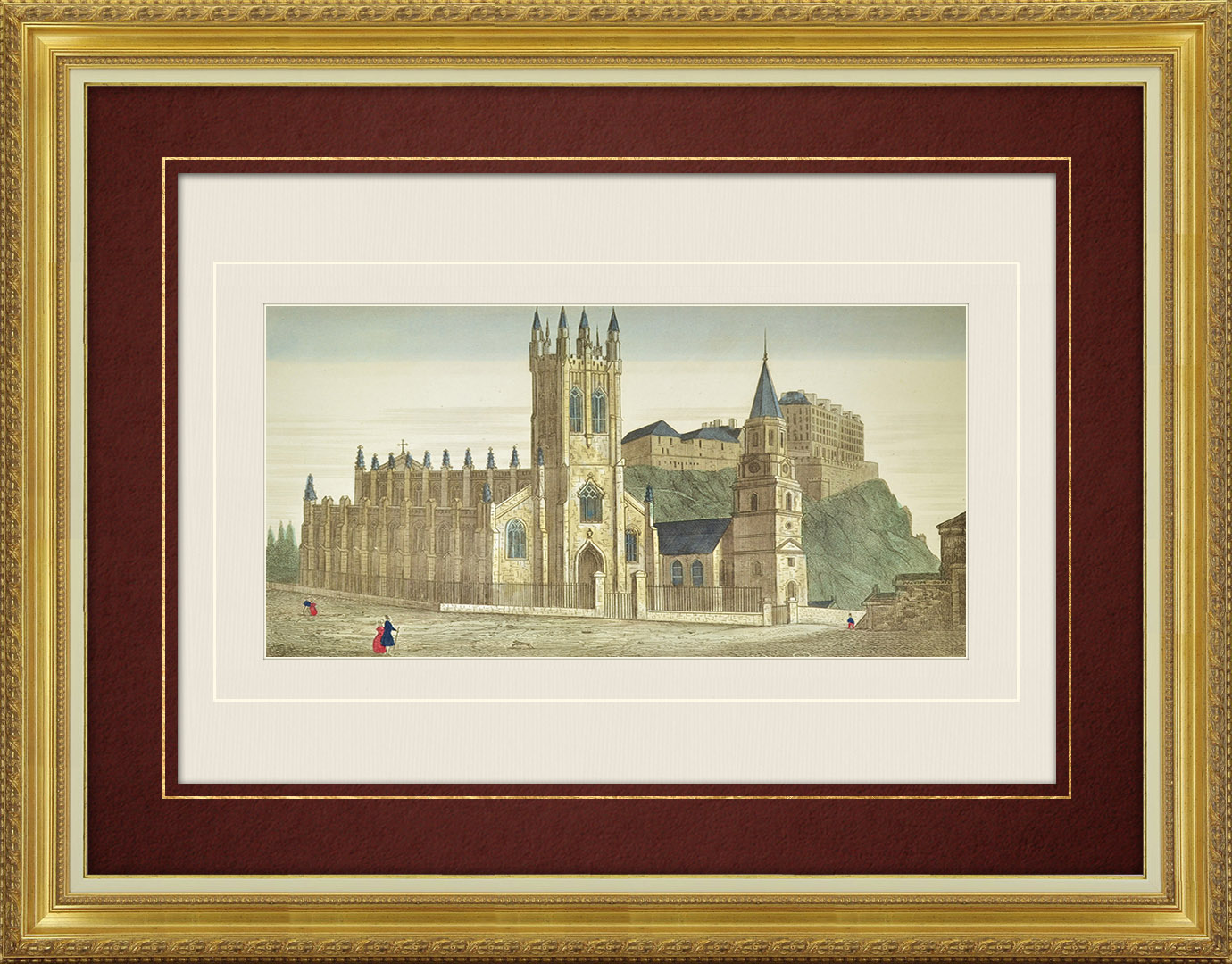
Original title
VUE DE LA CHAPELLE St. JEAN ET DE L'EGLISE St. CUTHBERT A EDIMBOURG
Mentions
A Paris chez BASSET Rue St Jacques N° 64
Description
Early XIXth century optical view in original watercolors. Original copper plate engraving heightened with watercolor at that time. Published by Basset in Paris circa 1830, depicting a view of the St Cuthbert's Church in Edinburgh (Scotland).
During the 18th Century, several renowned establishments in Paris, London (England), Augsburg (Germany) and Bassano (Italy) were specialized in the creation of these optical views. They could be viewed alone or through a zograscope, a wooden foot surmounted by a lens which enlarged the image and accentuated the perspective effect. They could also be placed in optical boxes, the spectator then looked inside the box through the lens. This distraction was greatly appreciated in the 18th Century in the salons of the bourgeoisie and the nobility as in the countryside thanks to the hawkers.
These etchings are nowadays exhibited in museums around the world and extremely appreciated by collectors and decorators for their historical interest and their high decorative value.
Condition report
Find more artworks related to these topics :
This strong water etching is listed in these categories :
A chapel dedicated to St Cuthbert is first mentioned in the 8th century. It is believed a church has definitely stood on the same site as currently used since 850 AD, making it Edinburgh's oldest building in terms of foundation. A mediaeval St. Cuthbert's church is mentioned in 1127. Early maps showing the church usually refer to it simply as West Church.
The parish boundaries of the church were somewhat eccentric, encompassing outlying villages such as Stockbridge and Canongate but oddly also taking in Edinburgh Castle.
In 1754 a Chapel of Ease was proposed for the South side of the parish, and approved by the Kirk Session. This chapel was opened in 1756 and accommodated 1200 people, having cost £640 and 10 shillings to construct.
By 1772 St. Cuthbert's kirk was structurally dangerous, and in 1773–1775 the architect-builder James Weir, of Tollcross, built a preaching box with two tiers of galleries reached by stairs in the pedimented western projection.
Between 1787 and 1790 the ground to the north of the church was drained for an extension of the burial ground, and in 1789–1790 Alexander Stevens built the spire which he probably designed himself.
The Galerie Napoléon is pleased to propose to you this strong water etching printed 194 years ago (around 1830).
As for all the antique prints in our catalogue, this optical view VUE DE LA CHAPELLE St. JEAN ET DE L'EGLISE St. CUTHBERT A EDIMBOURG datant de 1830 is dispatched worldwide within 24H in a Secured packaging, accompanied by its certificate of authenticity guaranteeing the name of the artists (draughtsman, engraver, editor), the impression process used (Strong water) and its date (1830).
In order to guarantee a perfect conservation in time, this strong water etching is dispatched, ready to be framed, under museum quality color passepartout (manufactured without acid in the pulp for a neutral pH) on a cream mountboard made from carton bois (also acid free & neutral pH), in a luxurious portfolio.
At the apogee of the mode for optical views, between 1750 and 1790, four European cities specialized in their edition: Paris (France), London (England), Augsburg (Germany) and Bassano (Italy).
Optical views are prized in very different social circles : pleasant recreation in aristocratic salons, the views are admired in beautiful and richly decorated optical boxes which are real works of art. The show was transformed into a real scientific experiment. But the optical views also entertained the people who were in a hurry when a hawker set up a box on a market and began to narrate the extraordinary events that had taken place in a more or less distant and inaccessible country.
There are three categories in the production of optical views.

With more than 20 years experience and a catalogue of more than 40.000 antique prints, drawings and historical documents dating from the 14th to the 19th century, the Galerie Napoléon, parisian antique dealer's gallery, is one of the world references in the field of antique prints,etchings and antique graphic arts.
In addition to thousands of impassioned of antique prints throughout the world, the Galerie Napoléon is honoured to count among its customers : national archives, museums, historical monuments and important home designer companies. All attracted by the extraordinary diversity of its catalogue and the quality and speed of its services.
This experience allows us to guarantee to each one of our customers the authenticity of the antiques in our catalogue and the shipment of their orders within 24 hours.

Customize for free the color of your museum quality bevel cut edge passepartout (acid free & neutral pH) among a color chart of 23 shades.
This option will be offered to you free of charge in the cart.
All our antiques can be shipped worldwide. The orders are dispatched within 24H in a secured packaging.
The Galerie Napoléon offers free shipping for all orders over 50EUR for France, 70EUR for all EU destinations and 90EUR for worldwide destinations.
For orders below these amounts, the shipping costs are 8EUR for France, 12EUR for all EU destinations and 17EUR for worldwide destinations.

























